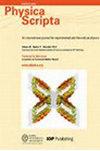硫化温度对合成用于太阳能电池的 Cu2ZnSnS4 薄膜晶粒生长的影响
IF 2.6
3区 物理与天体物理
Q2 PHYSICS, MULTIDISCIPLINARY
引用次数: 0
摘要
通过浸涂溶液法制备的铜锌锡硫(CZTS)薄膜是薄膜太阳能电池极具吸引力的吸收材料。这是因为它们价格低廉、成分环保、原材料丰富。虽然使用肼基溶液加工的薄膜效率最高,约为 12.6%,但肼的毒性和致癌性否定了这些优势。在全球正在进行的基于溶液的加工方法研究中,晶粒的大小已成为制造高效太阳能电池的关键因素。在我们的研究中,我们利用乙醇基前体溶液的浸涂工艺,成功制备了具有纯钾长石相的 CZTS 薄膜,其特征是具有大尺寸的微晶粒。我们研究了晶粒大小如何随硫化温度的变化而变化。值得注意的是,我们观察到温度升高会导致晶粒生长得更大、更均匀。这些结果凸显了我们的方法在直接生产具有较大晶粒的高质量薄膜方面的潜力,最终提高了薄膜的光敏性,使其成为高效太阳能电池应用的理想候选材料。本文章由计算机程序翻译,如有差异,请以英文原文为准。
Influence of sulfurization temperature on grain growth in Cu2ZnSnS4 thin films synthesized for solar cell applications
Copper-zinc-tin-sulfur (CZTS) thin films, prepared through a dip-coating solution method, present a highly attractive option as absorber materials for thin-film solar cells. This is due to their affordability, environmentally friendly composition, and abundant availability of raw materials. Although films processed with hydrazine-based solutions have achieved the highest efficiency of approximately 12.6%, the toxic and carcinogenic nature of hydrazine negates these advantages. In the ongoing global research on solution-based processing methods, the size of the grains has emerged as a critical factor in the fabrication of efficient solar cells. In our study, we have successfully prepared CZTS thin films with a pure kesterite phase, characterized by large micro-sized grains, using a dip-coating process with an ethanol-based precursor solution, followed by sulfurization. We investigated how the grain size evolves with varying sulfurization temperatures. Notably, we observed that increasing the temperature led to larger and more uniform grain growth. These results underscore the potential of our approach for the straightforward production of high-quality films with sizable grains, ultimately enhancing their photosensitivity and making them a promising candidate for efficient solar cell applications.
求助全文
通过发布文献求助,成功后即可免费获取论文全文。
去求助
来源期刊

Physica Scripta
物理-物理:综合
CiteScore
3.70
自引率
3.40%
发文量
782
审稿时长
4.5 months
期刊介绍:
Physica Scripta is an international journal for original research in any branch of experimental and theoretical physics. Articles will be considered in any of the following topics, and interdisciplinary topics involving physics are also welcomed:
-Atomic, molecular and optical physics-
Plasma physics-
Condensed matter physics-
Mathematical physics-
Astrophysics-
High energy physics-
Nuclear physics-
Nonlinear physics.
The journal aims to increase the visibility and accessibility of research to the wider physical sciences community. Articles on topics of broad interest are encouraged and submissions in more specialist fields should endeavour to include reference to the wider context of their research in the introduction.
 求助内容:
求助内容: 应助结果提醒方式:
应助结果提醒方式:


